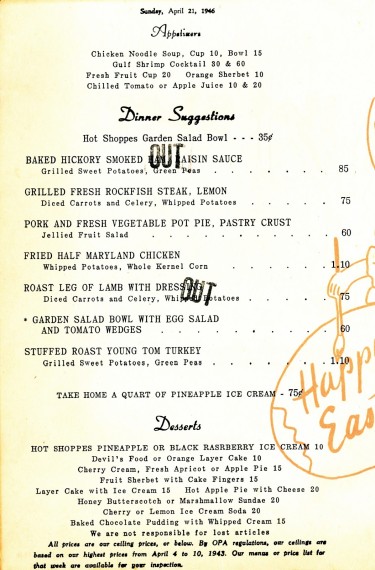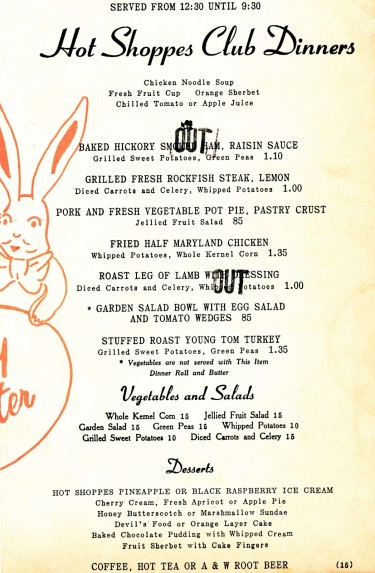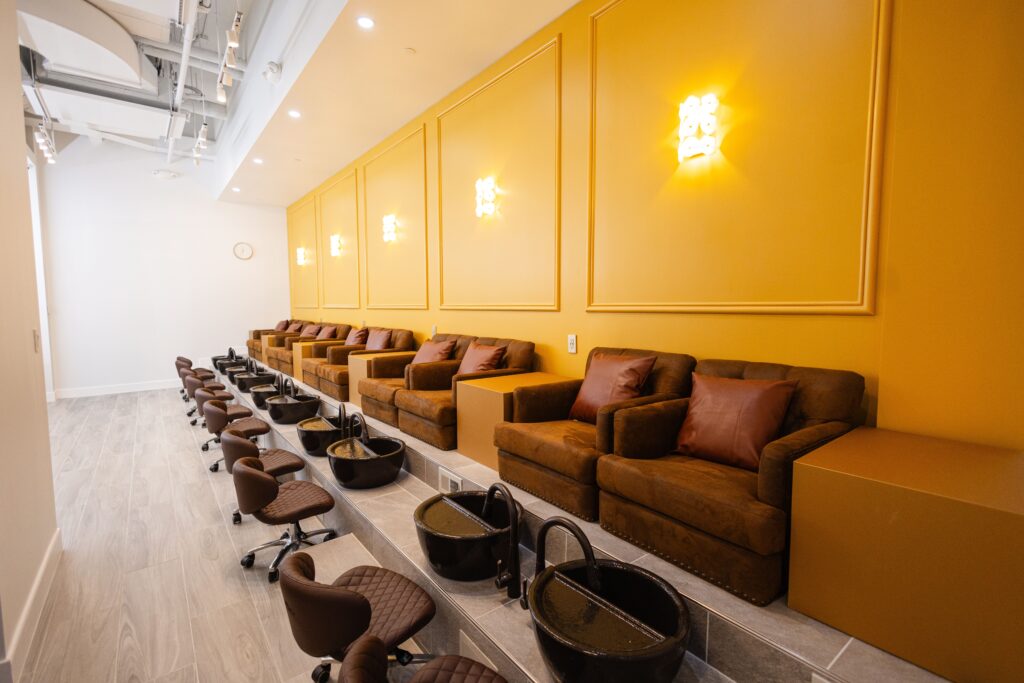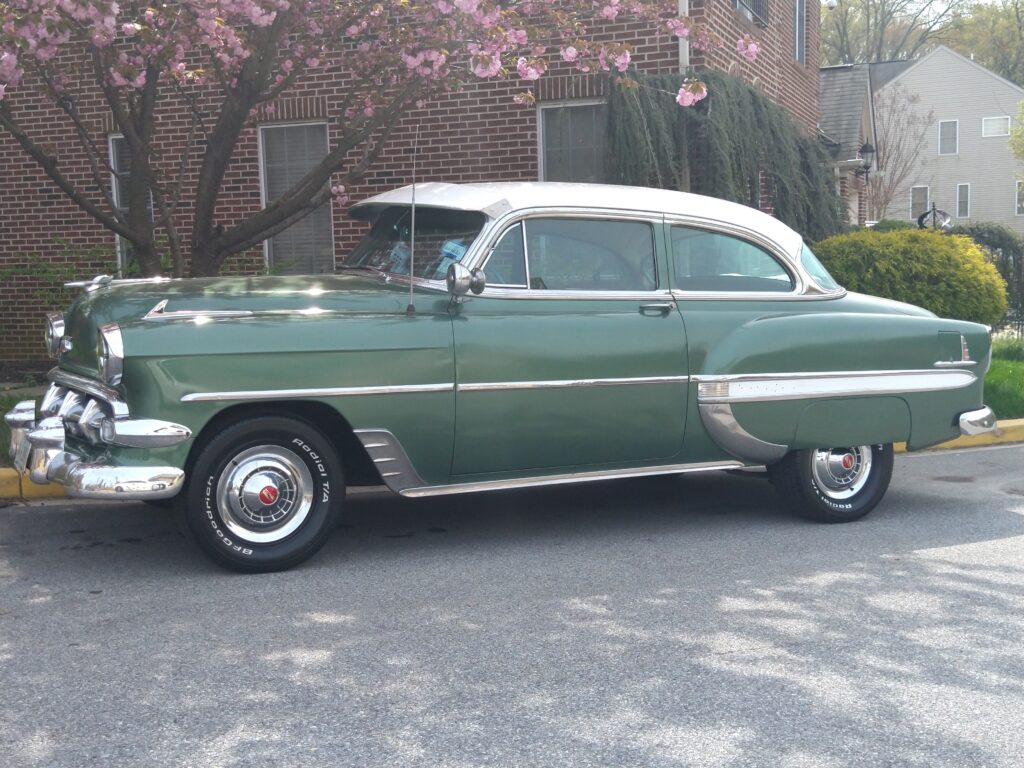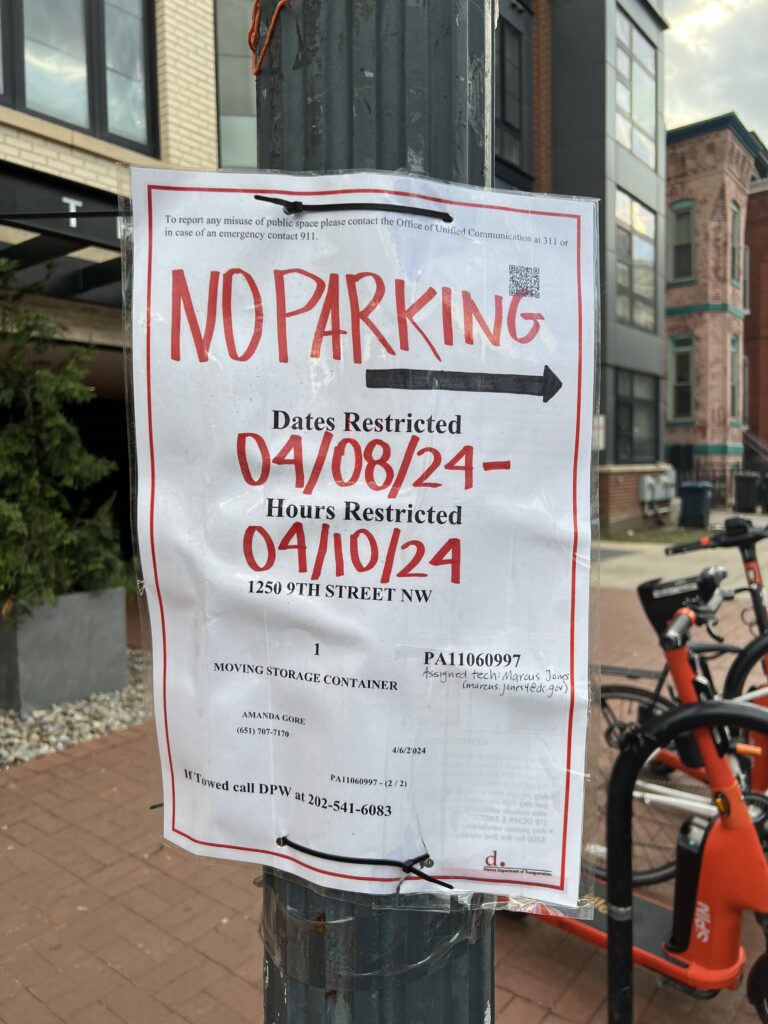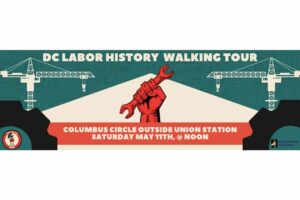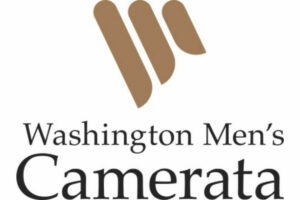Streets of Washington, written by John DeFerrari, covers some of DC’s most interesting buildings and history. A version of the following article will appear in Historic Restaurants of Washington, D.C.: Capital Eats, to be published this September by the History Press, Inc. John is also the author of Lost Washington DC.
Of all the mid-20th-century icons of everyday life in Washington, Hot Shoppes ranks among the most memorable. The chain of casual drive-in restaurants founded by J. Willard “Bill” Marriott (1900-1985) in 1927 once had a commanding presence at dozens of sites across the metropolitan area, serving up thousands of fast, friendly meals every day. Beginning with a tiny root beer stand in Columbia Heights, the chain rose rapidly to prominence in the 1930s, expanded in the 1940s and 50s, and then almost as dramatically dwindled away in the 1970s and 80s, eventually slipping into history after winning the hearts and stomachs of several generations of Washingtonians.
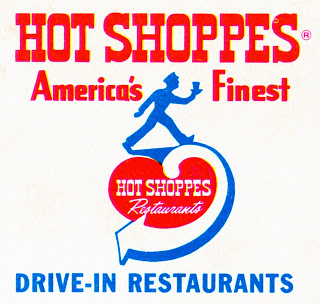
Matchbook cover from the early 1960s (Author’s collection).
The Marriott rags-to-riches story used to be one of the most oft told in the city. The son of a Utah sheep rancher, Bill Marriott was imbued at an early age with strong Mormon beliefs and an intense work ethic. As a teenager he experienced firsthand how hard it was to make a living raising livestock out west and resolved to get into a line of business less subject to market volatilities. In September 1921, after spending time in New York, Marriott passed through Washington on his way home to Utah. He spent a day sightseeing and noticed how vendors of ice cream, lemonade, and soda would sell out to the sweltering crowds practically as soon as they arrived on the scene with their carts. Six years later, when he was ready to start out on his own, Marriott decided to return to Washington to open a franchise selling A&W root beer.
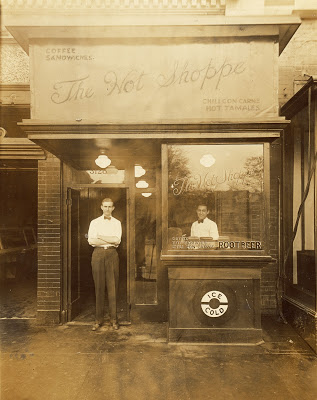
The original Hot Shoppe on 14th Street (photo courtesy Historic Photographs collection, Marriott International Archives).
With a partner from Utah, Marriott rented out a slim corner storefront at 3128 14th Street NW in the Arcade Market, where the DC-USA shopping center now stands. Inside was a counter with nine stools. Offering frosted mugs of cold root beer for a nickel, Marriott did a booming business. Within a few months, he had gone out to Utah to marry his college sweetheart, Alice “Allie” Sheets (1907-2000), driven her back to D.C. in his rickety Model T, and opened his second root beer stand downtown at 606 9th Street NW, another resounding success. While Allie counted the nickels every evening, separating the ones stuck together with root beer syrup, Bill would wrestle with problems like how to keep expensive frosted mugs from shattering when they were plunged into boiling water to be sanitized. (With the help of well-connected friends, he was able to get D.C. regulations changed to allow cool chlorine-based sanitization.)
Continues after the jump.
Selling root beer was great in warm weather, but once the temperatures dropped, Marriott needed something else to keep his business going. By some accounts it was Allie who came up with the scheme to sell Mexican food. Washington was no stranger to Mexican eateries, which typically featured hot tamales and chili con carne in those days. The Ranch, in business since 1900 at 507 F Street downtown, was a good example. The challenge was to get good recipes and find a source for quality ingredients. Bill recalled that the Mexican Embassy was located over on 16th Street, just a couple blocks away from their shop. Allie, who had majored in Spanish in college, talked the embassy’s chef into sharing recipes and providing contact information for a San Antonio supplier of Mexican foods. After that, all they needed was a name for the place. The story goes that a good friend asked, “Hey Bill, when are you and Allie going to open this hot shop I’ve been hearing about?” And so, with a few letters added to dress it up, the Hot Shoppes were born.
What to do next? For his third Hot Shoppe, at Georgia Avenue and Gallatin Street NW, Marriott planned something new, a drive-in like those he had known in Utah. The Georgia Avenue Hot Shoppe would be one of the first such restaurants on the East Coast, offering curbside service to customers who could drive up, order a meal, and eat it right in their cars off of a tray propped on the door. After struggling again with the D.C. government to get approval for the curb cuts he needed, Marriott opened the new Hot Shoppe in the summer of 1928. The little building in the center of the parking lot became a model for future Hot Shoppes, topped as it was by a bright orange roof to draw the attention of passing motorists—like the shops in the Howard Johnson chain that were getting started at about the same time.
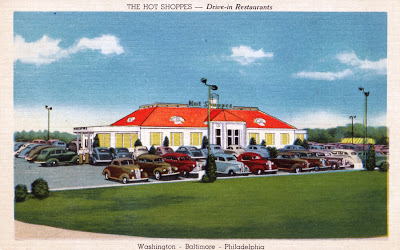
Postcard view of a typical 1940s Hot Shoppe (author’s collection).
Publicity for the new place invariable focused on the “curbers,” the young waiters who would run out to cars to take orders and run back with trays of food, all for whatever they could earn in tips. Marriott commissioned a graphic artist to design a logo for Hot Shoppes featuring one of these newly-famous “Running Boys,” who epitomized the Hot Shoppes’ cheerful, automobile-friendly service.
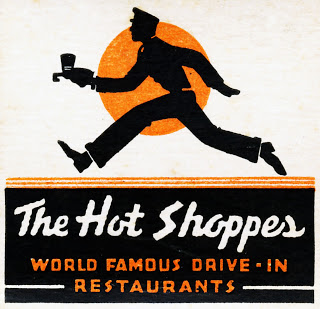
Matchbook cover from the 1940s (Author’s collection).
The Georgia Avenue store was shrewdly located away from downtown competitors and on a major artery where it could lure in commuters. The Marriotts took to staking out major roads and intersections around the city to try to pinpoint the best locations for future Hot Shoppes. The next to open would become the chain’s flagship, at 4340 Connecticut Avenue NW, in the area now known as Van Ness. Opened in 1930, this was the fifth Hot Shoppes. Mrs. Marriott later recalled that the Connecticut Avenue site was “pretty much a wilderness” when they moved in, although plenty of automobile traffic already flowed past. Like the Georgia Avenue store, this was a low, orange-roofed structure in the center of a large parking lot. The curbers brought it to life. When it opened the shop had 50 curbers; 40 girls and 10 boys. It soon had to add 50 more. In the midst of the Depression, the jaunty Hot Shoppe with its exuberant curbers was among the city’s trendiest destinations, particularly for high school and college kids looking for inexpensive eats.
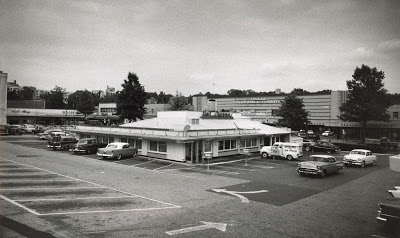
View of the Connecticut Avenue Hot Shoppe, circa 1957. The former Chevy Chase Ice Palace is visible in the rear. It was a studio for the WMAL Channel 7 TV station at the time (photo courtesy Historic Photographs collection, Marriott International Archives.)
By 1933 there were six Hot Shoppes across the city grossing $1 million annually, and more were being added all the time. In 1938 Marriott built offices and a central commissary, including a kitchen, bakery, and butcher shop, at 1234 Upshur Street NW in Petworth to supply and oversee all his eateries. That same year, developer Garfield I. Kass built the snazzy Chevy Chase Ice Palace and Sports Center (see previous Streets of Washington article) directly across the street from the Connecticut Avenue Hot Shoppe, instantly supplying it with hordes of new customers, hungry and thirsty after their workouts on the skating rink or at the bowling alleys. Throughout the war years, a steady stream of servicemen and civilian workers would wend their way up Connecticut Avenue on their free nights to take in the twin attractions of the Ice Palace and the Hot Shoppe.
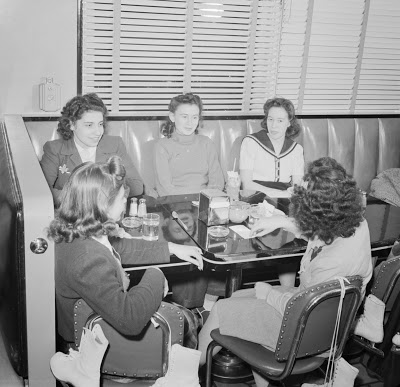
Girls at the Connecticut Avenue Hot Shoppe after skating at the Chevy Chase Ice Palace, December 1941 (Source: Library of Congress).
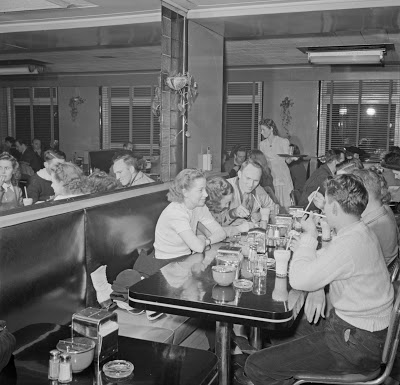
Another scene from the same busy night in December 1941 (Source: Library of Congress).
The chain’s Mexican cuisine, supplemented by barbecue, had quickly evolved into a classic line-up of what people now call comfort food—hamburgers, steak sandwiches, grilled cheese, ham and eggs. A wartime menu featured an assortment of sandwiches some of which would be a hard sell today: peanut butter and lettuce, fried egg with grilled spiced meat loaf, liverwurst with lettuce and egg salad. Main entrees included creamed flaked tuna fish on toast and “crab meat and chopped egg in a tomato,” among other items.
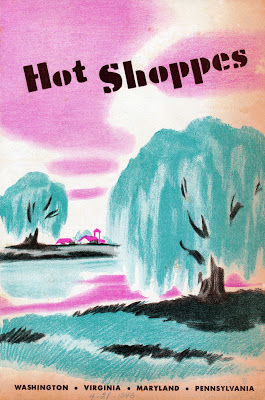
A special Easter 1946 Hot Shoppes menu (Author’s collection). Click on any of the images in this article to see a larger version.
By the 1950s the chain took on a more up-to-date, fast food profile, highlighting new inventions like the Mighty Mo, a tasty triple-decker hamburger named after the battleship U.S.S. Missouri, which had just been retired. The Mighty Mo competed with the Big Boy, a triple-decker burger offered by rival Bob’s Big Boy (which Marriott Corporation would later buy). The Hot Shoppes was also known for its grilled ham sandwich, called the Teen Twist, as well as its breaded onion rings, a milkshake called the Orange Freeze, and Pappy Parker’s fried chicken.
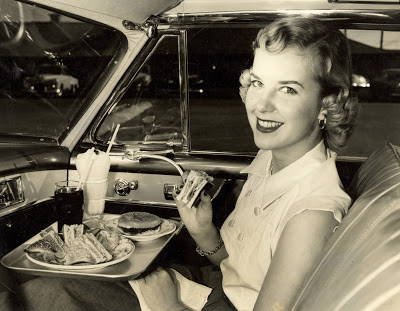
Hot Shoppes drive-in eating, circa 1952 (photo courtesy Historic Photographs collection, Marriott International Archives).
The original tiny Hot Shoppe on 14th Street had closed in 1935, but in 1950 Hot Shoppes returned to Columbia Heights with a new coffee shop and pantry house around the corner at 1404 Park Road NW. Longtime neighborhood residents recall that, unlike the Waffle Shop next door, the Hot Shoppe welcomed African American customers. The Hot Shoppes chain had always tried to cultivate its image as a welcoming, family-oriented eatery. In 1955, waitress Beulah Heflin of the Park Road Hot Shoppe won the “Miss Good Morning” title as the most polite hostess in D.C., part of a nationwide contest sponsored by Kellogg cereals. Her counterparts in Maryland and Virginia won for their jurisdictions as well.
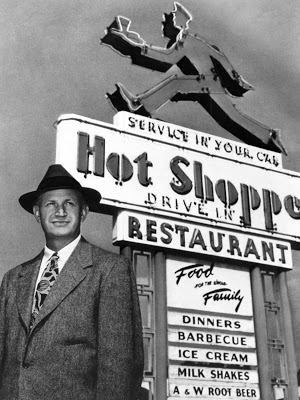
Undated photo of J.W. Marriott (photo courtesy Historic Photographs collection, Marriott International Archives).
By 1964, a total of 73 Hot Shoppes restaurants and cafeterias were operating in 13 states and the District, including food service operations at hotels and other institutions as well as highway rest stops. One of the largest fast food chains in the country, the combined operation used more steaks than any other enterprise except the U.S. Army. Indeed, Hot Shoppes seemed to be on top of the world in those days, at least in the Washington area, but change was already in the air. The company modified its name that year to “Marriott Hot Shoppes, Inc.,” and in 1967 dropped the “Hot Shoppes” part altogether. That was the same year the last Hot Shoppe was built.
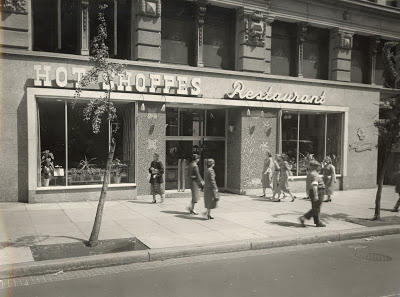
Hot Shoppe in the Colorado Building at 14th and G Streets NW, circa 1955 (photo courtesy Historic Photographs collection, Marriott International Archives).
The shift in direction had started back in 1957. That was the year the company’s first hotel, the sprawling 110-room Twin Bridges Marriott, opened in Arlington, right at the Virginia end of the 14th Street Bridge. Marriott’s son, Bill Marriott, Jr., had orchestrated the hotel’s opening, and within a year he was named head of the company’s embryonic hotel division. Under his leadership, the company’s energies increasingly focused on its hotels and away from the iconic Hot Shoppes. In 1974, two years after he took over as CEO, Bill, Jr., announced that the company was planning to phase out its Hot Shoppes brand. The iconic eateries were too costly to run, he said, and at around 3 percent, their profit margin was too thin.
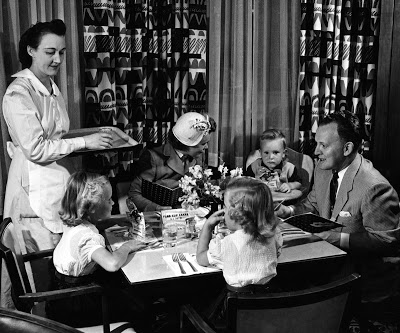
Family dining at the Hot Shoppes, circa 1954 (photo courtesy Historic Photographs collection, Marriott International Archives).
There were only 20 Hot Shoppes left that year (not including the various food service operations and other eateries like Jr. Hot Shoppes), and 8 of those were slated to close, dropping the total to 12. The remaining dozen, it was promised, would remain open as long as they were profitable. The flagship Connecticut Avenue Hot Shoppe was one of the ones closed that year. It was sold for $6.5 million to the National Bank of Washington, which razed the old eatery and replaced it with a 5-story office building. (The structure still stands today and is owned by the University of the District of Columbia. The Ice Palace building across the street is also still standing but is to be torn down this summer.) Another Hot Shoppe remained open nearby at 4110 Wisconsin Ave NW, but it too closed in 1977. Meanwhile the company’s 34 Junior Hot Shoppes were converted to the Roy Rogers nameplate. The Roy Rogers chain, which specialized in roast beef sandwiches, was considered more profitable. It had more expensive offerings, didn’t offer wait service, and didn’t stay open late at night. The corporate accountants much preferred it.
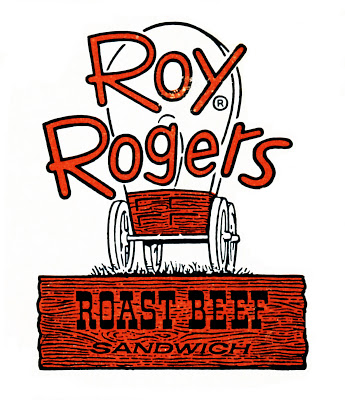
Roy Rogers matchbook cover (Author’s collection).
As Marriott Corporation continued to grow and dominate the hotel business, it seemed to lose interest in restauranting. In 1989 the company announced it was getting out of the fast food space altogether rather than continuing to compete with the likes of McDonald’s and other hard chargers. By this time it owned the Bob’s Big Boy and Howard Johnson’s chains that had challenged Hot Shoppes in the old days, as well as its own Roy Rogers brand, and the decision was made to sell them all off. The dozen remaining Hot Shoppes would be spared for “auld lang syne,” as Bill Marriott, Jr., explained.
One by one the remaining 12 eventually closed as their leases expired and weren’t renewed. The newspapers ran stories about people who had been going to Hot Shoppes for 20 or 30 or 40 years. “This was where I met my husband,” one old-timer told the Washington Post in 1995 when the Bethesda Hot Shoppe was closing. Gene Kelley, another long-time patron, summed it up: “For my generation, this was it. I hate to see the change. I think it’s very sad. It’s progress, but I don’t want to be here for it.” The very last Hot Shoppe to close was the one in the Marlow Heights Shopping Center in Temple Hills, Maryland, which was shuttered in November 1999. With that, the chain became extinct, although every now and then glimmers of the past have been known to surface. It’s said you can order a Mighty Mo, even though it’s not on the menu, at certain Marriott hotels, and they’ll serve it to you on a Hot Shoppes plate. And the new downtown Marriott Marquis being built at 9th Street and Massachusetts Avenue NW may offer some of the old Hot Shoppes menu items when it opens in 2014. The legend, quaint as it may be, lives on.
* * * * *
Special thanks to Beth Schuster, Corporate Archivist at Marriott International, Inc., for her gracious assistance in locating and sharing vintage photographs from the Marriott archives. Additional sources for this article included John Mariani, America Eats Out (1991); Marriott Corporation, Hot Shoppes Cookbook (1987); Robert O’Brien, Marriott: The J. Willard Marriott Story (1977); Richard Pillsbury, From Boarding House to Bistro (1990); and numerous newspaper and magazine articles.
Recent Stories
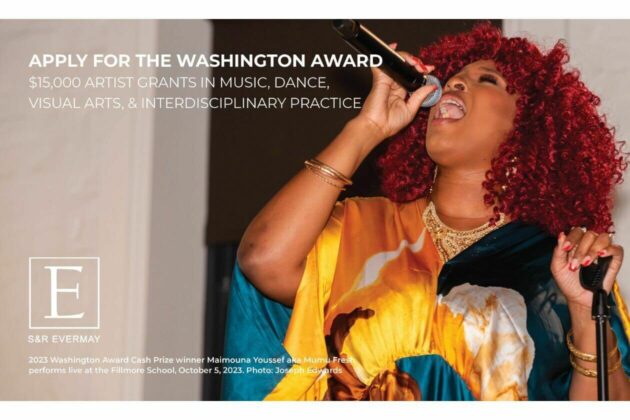
We are excited to announce that the 2024 Washington Award application opened today!
The 2024 Washington Award offers four cash prize awards of $15,000 for individual artists working in the field of music, dance, visual arts, and interdisciplinary practice (one award per category). This award, one of the largest grants in D.C. available to individual artists, provides unrestricted cash support to artists at critical moments in their careers to freely develop and pursue their creative ideas.
Since its inception in 2001, the Washington Award has recognized artists in music, dance, interdisciplinary practice, and visual arts. In a renewed commitment to supporting the artistic community of Washington DC, the Washington Award is eligible to DC artists who prioritize social impact in their practice.

Unlike our competitors, Well-Paid Maids doesn’t clean your home with harsh chemicals. Instead, we handpick cleaning products rated “safest” by the Environmental Working Group, the leading rating organization regarding product safety.
The reason is threefold.
First, using safe cleaning products ensures toxic chemicals won’t leak into waterways or harm wildlife if disposed of improperly.
DC Labor History Walking Tour
Come explore DC’s rich labor history with the Metro DC Democratic Socialists of America and the Labor Heritage Foundation. The free DC Labor History Walking Tour tour will visit several landmarks and pay tribute to the past and ongoing struggle
Frank’s Favorites
Come celebrate and bid farewell to Frank Albinder in his final concert as Music Director of the Washington Men’s Camerata featuring a special program of his most cherished pieces for men’s chorus with works by Ron Jeffers, Peter Schickele, Amy


